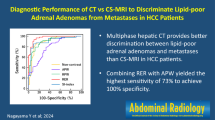Abstract
Purpose
To determine the utility of non-contrast-enhanced CT (NC-CT) for improved detection of hyperenhancement in hepatocellular carcinomas (HCC).
Methods
We performed a retrospective analysis on CT studies of 104 consecutive patients with 124 HCCs between October 2006 and December 2012. The enhancement of HCC was evaluated on quadriphasic CT: non-contrast (NC), arterial phase (AP), portal-venous phase (PVP), and delayed phases (DP) were performed. For determination of enhancement, mean attenuation of the HCC and surrounding non-tumor bearing liver in the four phases were recorded. Hyperenhancement was defined by either HCC (AP-NC) representing absolute lesion enhancement or AP (HCC-liver), representing relative enhancement. An increase of ≥10 Hounsfield units (HU) was considered as enhancement. Two radiologists (R1 and R2) independently performed a conventional qualitative assessment for hyperenhancement of HCC. The accuracy of detection by proposed absolute lesion enhancement HCC (AP-NC) was compared to relative enhancement AP (HCC-liver) and qualitative assessment by readers with the McNemar test.
Results
The proposed criteria of absolute lesion enhancement, HCC (AP-NC) identified more hypervascular nodules compared to qualitative analysis (92% vs. 62% for R1 and 69% for R2), equating to an improvement of 23%–31%. In contrast, relative enhancement AP (HCC-liver) was found to be inferior to conventional qualitative analysis (50% vs. 62%–69% for readers).
Conclusion
NC-CT is useful to improve the detection of hyperenhancement in HCCs for imaging diagnosis.




Similar content being viewed by others
References
Ferlay J, Shin HR, Bray F, et al. (2008) Estimates of worldwide burden of cancer in 2008: GLOBOCAN 2008. Int J Cancer 127(12):2893–2917. doi:10.1002/ijc.25516
Bruix J, Sherman M, Llovet JM, et al. (2001) Clinical management of hepatocellular carcinoma. Conclusions of the Barcelona-2000 EASL conference. European association for the study of the liver. J Hepatol 35(3):421–430
Bruix J, Sherman M, Practice Guidelines Committee, American Association for the Study of Liver Diseases (2005) Management of hepatocellular carcinoma. Hepatology 42(5):1208–1236
Omata M, Lesmana LA, Tateishi R, et al. (2010) Asian Pacific association for the study of the liver consensus recommendations on hepatocellular carcinoma. Hepatol Int 4(2):439–474. doi:10.1007/s12072-010-9165-7
Bolondi L, Gaiani S, Celli N, et al. (2005) Characterization of small nodules in cirrhosis by assessment of vascularity: the problem of hypovascular hepatocellular carcinoma. Hepatology 42(1):27–34
Burrel M, Llovet JM, Ayuso C, et al. (2003) MRI angiography is superior to helical CT for detection of HCC prior to liver transplantation: an explant correlation. Hepatology 38(4):1034–1042
Sangiovanni A, Manini MA, Iavarone M, et al. (2010) The diagnostic and economic impact of contrast imaging techniques in the diagnosis of small hepatocellular carcinoma in cirrhosis. Gut 59(5):638–644. doi:10.1136/gut.2009.187286
Bruix J, Sherman M; American Association for the Study of Liver Diseases (2011) Management of hepatocellular carcinoma: an update. Hepatology 53(3):1020–1022
Colli A, Fraquelli M, Casazza G, et al. (2006) Accuracy of ultrasonography, spiral CT, magnetic resonance, and alpha-fetoprotein in diagnosing hepatocellular carcinoma: a systemic review. Am J Gastroenterol 101(3):513–523
Ma Y, Zhang XL, Li XY, et al. (2008) Value of computed tomography and magnetic resonance imaging in diagnosis and differential diagnosis of small hepatocellular carcinoma. Nan Fang Yi Ke Da Xue Xue Bao 28(12):2235–2238
Li CS, Chen RC, Tu HY, et al. (2006) Imaging well-differentiated hepatocellular carcinoma with dynamic triple-phase helical computed tomography. Br J Radiol 79(994):659–665
Park YN, Yang CP, Fernandez GJ, et al. (1998) Neoangiogenesis and sinusoidal capillarization in dysplastic nodules of the liver. Am J Surg Pathol 22(6):656–662
Marrero JA, Hussain HK, Nghiem HV, et al. (2005) Improving the prediction of hepatocellular carcinoma in cirrhotic patients with an arterially-enhancing liver mass. Liver Transpl 11(3):281–289
Yoon SH, Lee JM, So YH, et al. (2009) Multiphasic MDCT enhancement pattern of hepatocellular carcinoma smaller than 3 cm in diameter: tumor size and cellular differentiation. AJR Am J Roentgenol 193(6):W482–W489. doi:10.2214/AJR.08.1818
Tan CH, Thng CH, Low AS, et al. (2011) Wash-out of hepatocellular carcinoma: quantitative region of interest analysis on CT. Ann Acad Med Singapore 40(6):269–275
Oliver JH 3rd, Baron RL, Federle MP, Rockette HE Jr (1996) Detecting hepatocellular carcinoma: value of unenhanced or arterial phase CT imaging or both used in conjunction with conventional portal venous phase contrast-enhanced CT imaging. AJR Am J Roentgenol 167(1):71–77
Doyle DJ, O’Malley ME, Jang HJ, Jhaveri K (2007) Value of the unenhanced phase for detection of hepatocellular carcinomas 3 cm or less when performing multiphase computed tomography in patients with cirrhosis. J Comput Assist Tomogr 31(1):86–92
Iannaccone R, Laghi A, Catalano C, et al. (2005) Hepatocellular carcinoma: role of unenhanced and delayed phase multi-detector row helical CT in patients with cirrhosis. Radiology 234(2):460–467
Mettler FA Jr, Huda W, Yoshizumi TT, Mahesh M (2008) Effective doses in radiology and diagnostic nuclear medicine: a catalog. Radiology 248(1):254–263
Author information
Authors and Affiliations
Corresponding author
Rights and permissions
About this article
Cite this article
Hennedige, T., Yang, Z.J., Ong, C.K. et al. Utility of non-contrast-enhanced CT for improved detection of arterial phase hyperenhancement in hepatocellular carcinoma. Abdom Imaging 39, 1247–1254 (2014). https://doi.org/10.1007/s00261-014-0174-1
Published:
Issue Date:
DOI: https://doi.org/10.1007/s00261-014-0174-1




